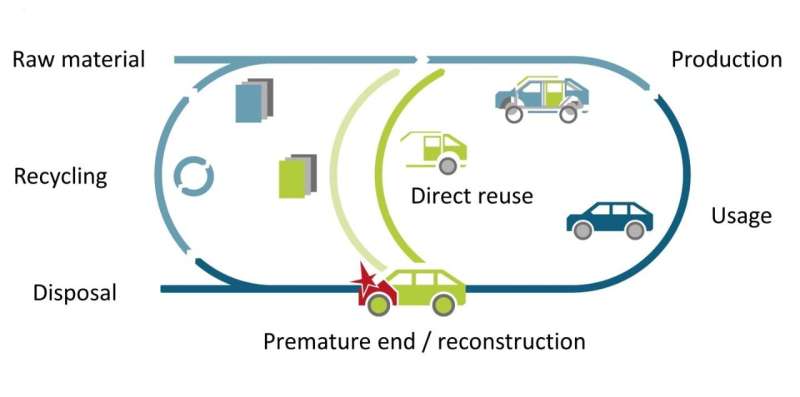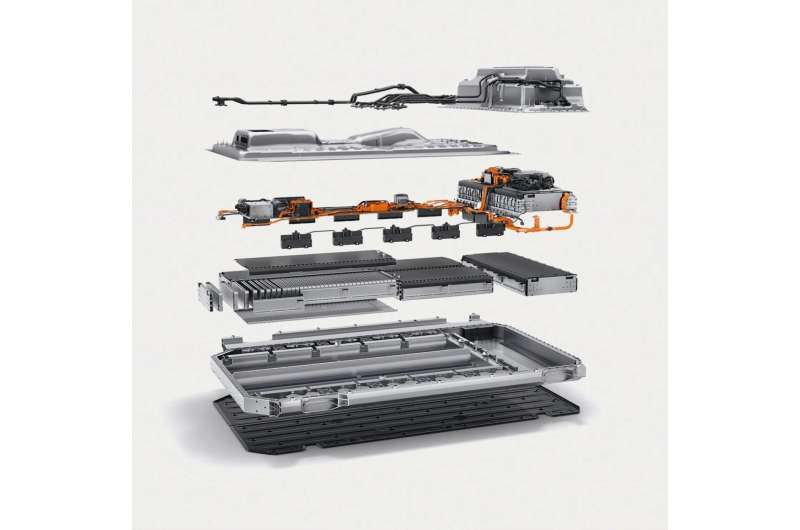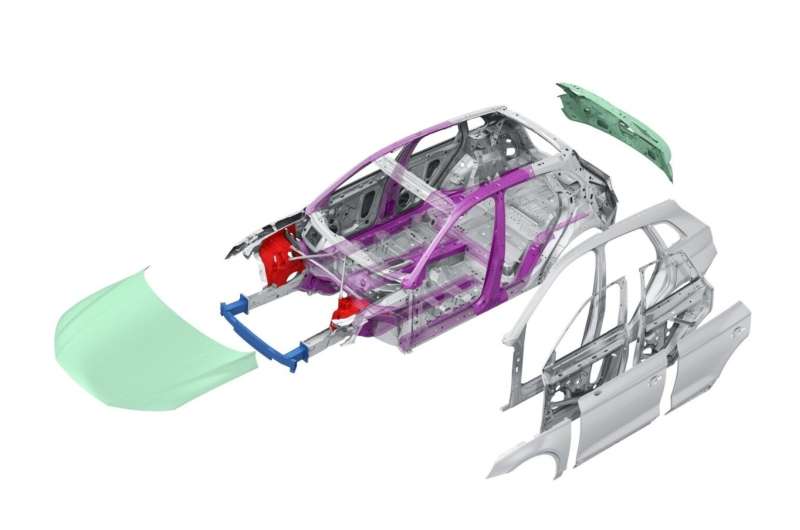This article has been reviewed according to Science X's editorial process and policies. Editors have highlighted the following attributes while ensuring the content's credibility:
fact-checked
trusted source
proofread
A second chance for batteries, gearboxes and cog-wheels

Used and damaged cars are often disposed of via energy-intensive scrapping processes—even when many of their parts are still fully functional. In the EKODA project, Fraunhofer researchers are developing a better alternative. First, they examine each component in a complex testing procedure. Then they use an evaluation system to generate recommendations for how these components could be reused.
This strategy optimizes the lifespan of the individual parts, making it possible to establish a sustainable circular economy in the mobility sector. Used batteries, gear shafts and cogwheels could even show up in other applications outside the automotive industry.
A camera moves slowly over a lithium ion battery, which has just been extracted from a car that was damaged in an accident. It records the battery type, model, serial number and power class (in kilowatts) and compares this information with an internal database. Next, the battery cover is removed through a semi-automated process. And then comes more analysis. A measuring system records the battery's current charge level, the functionality of its control electronics and the condition of the individual battery cells.
Evaluation software developed by the Fraunhofer Institute for Machine Tools and Forming Technology IWU then uses this data to create a detailed profile of the battery condition, which is analyzed and used to provide recommendations for reuse. An intact battery that is only three or four years old, for example, could be transferred to a used car of the same type. If the energy storage system is older, it would be possible to use it in a smaller agricultural machine. Even if the battery has multiple defective cells, it may still be suitable for stationary use, for example, as electricity storage in a home photovoltaic system.
The battery system does not need to be thrown away. It gets a second chance that is tailored to its specific abilities. The same principle of examination and reuse can be applied to other car parts too. "The decisive factor here is that the individual parts are disassembled carefully via a standardized and automated process, as we need to find possible ways of reusing the components right from the start," explains Dr. Uwe Frieß, head of the department for body construction, assembly and disassembly at Fraunhofer IWU.

A team of researchers from Fraunhofer IWU in Chemnitz are currently developing and optimizing the above-mentioned evaluation system. The software, which is equipped with AI algorithms, is one of the core technologies of the EKODA project—which aims to bring about a circular economy through efficient, economically viable disassembly and processing. Part of its mission is to set out on the "path to sustainable mobility through circular value creation." Aside from Fraunhofer IWU, other members of the project consortium include the Fraunhofer Institute for Environmental, Safety and Energy Technology UMSICHT in Oberhausen and an array of partners from the world of industry.
The project has an ambitious goal, as Dr. Frieß reveals: "We want to move away from traditional recycling, instead looking at every component of a car as a valuable resource—regardless of the function they currently serve in the vehicle. This is why we are working on a strategy for testing whether these individual components can be reused or repurposed in various contexts."
Fraunhofer IWU researchers are also working on processes for automatically disassembling the individual components. By implementing this strategy systematically, the researchers hope to enable reuse of all components as part of a circular economy. As this would reduce the need to manufacture new products, it would reduce both costs and CO2 emissions. Not only that, but it would also reduce or eliminate the need to prematurely scrap cars that may still be partially intact, or to export defective second-hand cars to countries in the global South—which makes little ecological sense.
Bodies, drive shafts, gears
The Chemnitz-based researchers are not only analyzing battery storage systems—they are also focusing on parts such as the car body and the drive train. Some parts of the drive train, such as shafts or cogwheels made of metal or steel, could also be suited for remanufacturing. For example, it could be worth a try to reduce the size of steel shafts through a reshaping process, allowing the shafts to be used in another mobility application.
"A cogwheel from a defective gearbox could be reused in a refurbished electric scooter, to name just one example," explains Dr. Frieß. Fraunhofer IWU is bringing its researchers' many years of experience in the field of resource-efficient production to bear in both the evaluation system and in the development of processes for automatic disassembly and metalworking during remanufacturing.

Dynamic real-time updates
"The evaluation system that we are building is designed to be complex and holistic. Ecological criteria will be given the same weight as technological and economical factors, such as CO2 emissions and energy consumed during repurposing, for example," explains Patrick Alexander Schmidt, a researcher at Fraunhofer IWU. "The evaluation system will also take into account fluctuations in electricity prices in a dynamic way, based on the relevant daily figures," promises Mr. Schmidt.
The Fraunhofer researchers and their partners want to take the development and design of the evaluation system a step further. They are looking at supply chains, repair shops and car dismantlers—in the future, their requirements or requests for spare parts could be incorporated into the evaluation system's data pool. The system would then be able to tell that the specific component it is testing is needed by a local workshop that is repairing a broken tractor, for example.
This way, the automotive industry and its suppliers could form new lines of business focused on organizing sustainable ways of using all components. Another research partner in the project, the Fraunhofer Institute for Environmental, Safety and Energy Technology UMSICHT is developing circular business models that could be implemented effectively in a variety of industries.
















